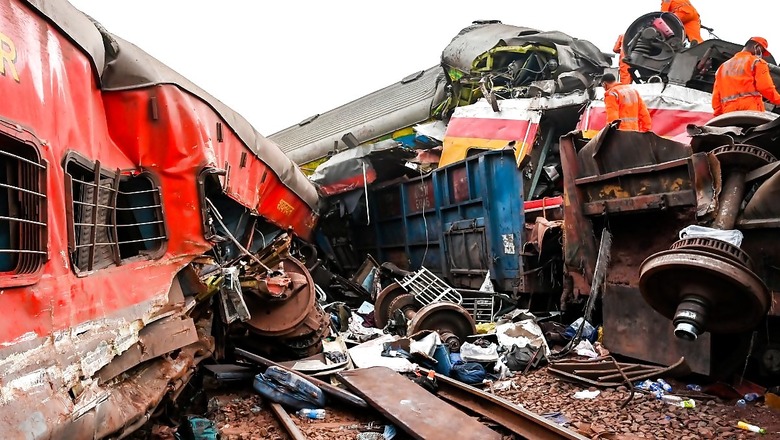
views
The triple-train accident in Odisha’s Balasore on June 2, which killed 295 passengers and grievously injured 176 others, occurred due to lapses in the signalling-circuit alteration carried out during the replacement of an electric lifting barrier at a level-crossing gate, Union Railway Minister Ashwini Vaishnaw stated in parliament on Friday citing findings from the Commissioner of Railway Safety’s report.
The Shalimar-Chennai Central Coromandel Express (12841) rammed into a stationary goods train, causing its coaches to fall on the adjacent track and collide with the Bengaluru-Howrah Superfast train coming from the opposite direction in June, killing nearly 300 people in one of the worst train accidents in India in decades.
Earlier this month, a ministry official, speaking to News18, confirmed that human error was responsible for the incident. However, due to the ongoing CBI probe, the official said that they could not disclose further details.
Findings of Commissioner of Railway Safety’s Report
The report was disclosed on Friday in response to questions from Rajya Sabha members regarding the accident.
In written responses, Vaishnaw said the rear-collision happened due to lapses in the signalling-circuit alteration carried out at the North Signal Goomty in the past and during the execution of the signalling work related to the replacement of an electric lifting barrier for a level-crossing no. 94 at the station.
“These lapses resulted in wrong signalling to the Train No. 12841 wherein the UP Home Signal indicated Green aspect for run-through movement on the UP main line of the station, but the crossover connecting the UP main line to the UP loop line (crossover 17 A/B) was set to the UP loop line; the wrong signalling resulted in the Train No. 12841 traversing on the UP loop line, and eventual rear-collision with the goods train (No. N/DDIP) standing there,” he said.
News18 had earlier reported that the findings of the Commission of Railway Safety’s investigation have pointed to the mishap being primarily caused by wrong signalling and human errors at multiple levels.
’13 Cases of Signalling Failure in 5 Years’
Vaishnav stated that over the past five years, there have been 13 instances of signalling failure in the railways with seven of these being consequential accidents. There have been no incidents attributed to defects in the interlocking signal system, he added.
The consequential accidents are those that have serious repercussions in terms of either one or many or all of the following: loss of human life, human injury, loss of railway property, and interruption to rail traffic. The railway data, seen by News18, shows that no deaths were reported in these seven accidents; however, there was a loss of railway property.
The data shows that in 2018-19, three accidents took place due to signal issues, and all three were consequential. The next year, four such incidents took place, with two of these being consequential. In 2020-21, when Covid-induced lockdown was imposed, there were no such accidents. The following year, in 2021-22, one accident took place due to a signalling issue, and it was consequential.

During 2022-23, this number increased drastically to five, with one accident being consequential.
In another statement, the Ministry said that while there have been signal failures, none of them could lead to a Balasore-like incident.
However, ministry data reported by News18 earlier this month contradicts this, with a total of 7,216 signal failures reported across India in June alone. According to the data available, 16,458 signal failures were reported during April-June, averaging approximately 183 incidents per day.
Signal Failures ‘Exceptionally High’ Across Railway Zones in June, 240 Incidents Per Day on Average
Overhead equipment failures also increased, with 251 incidents in June compared to 199 last year, data showed.
Responding to the data findings, an Indian Railways official had attributed these numbers to the large volume of trains and machines, stating that failures are common in any system.
41 Victims Yet to be Identified
The Union Minister revealed that 41 victims of the accident are yet to be identified among the total 295 killed. Out of the deceased, 254 have been identified as of July 18. The Ministry retained the mortal remains of unidentified passengers at AIIMS, Bhubaneswar, preserving DNA samples for analysis at CFSL, New Delhi.
Referring to the Ministry of Railways’ enhanced ex-gratia payment of Rs 10 lakh each to the next of kin of the deceased, Rs two lakh each to the grievously injured and Rs 50,000 each to those with simple injuries, the minister said so far, Rs 29.49 crores has been paid as ex-gratia until July 16.
Earlier this month, the Central Bureau of Investigation (CBI) made its first arrests in connection with the June 2 Balasore train accident, taking three railway personnel into custody. The accused, Senior Section Engineer (signal) Arun Kumar Mahanta, Section Engineer Mohammed Amir Khan, and Technician Pappu Kumar, all of whom were posted in Balasore district, were charged under IPC sections 304 (culpable homicide not amounting to murder) and 201 (destruction of evidence).
The accident triggered a shakeup in the South Eastern Railway (SER), resulting in the removal of at least seven senior-most officials. Among those affected, five senior officials, including the Kharagpur Divisional Railway Manager and Principal Chief Safety Officer, were transferred. Additionally, Archana Joshi, the General Manager of South Eastern Railway, was also transferred from her post, and Anil Kumar Mishra was appointed as her successor.
(With inputs from Nivedita Singh)















Comments
0 comment